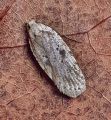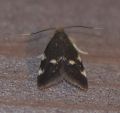2023 Annual Report for: Depressariidae / Depressariinae
For species seen in 2023 that had less than or equal to 100 records, full details are included; for more common species, the earliest, latest and highest count by vice-county are shown. The narrative for each species is taken from the main Hantsmoths website, and it is possible that some information on abundance and occurrence can get out of date, as it is impossible to keep up with all changes; however it should give a good introduction to each species. The tables in each species account summarise the previous status, and that for the current year.
For the maps, all records prior to 2023 are shown by a blue dot (the larger the dot, the more recent), with the current year's records shown in red. As previous records are superimposed on any report for 2023, new sites have greater emphasis (i.e. will show as 'more red').
In the species accounts, an asterisk next to a location indicates a new 10km square record; earliest ever dates are highlighted in orange, and latest ever in red. Initials in the species accounts refer to the recorders listed here. Please get in touch if you identify any omissions or errors, in particular if you have records that have yet to be submitted. Details of how to submit records can be found here.
32.002 [B&F: 0667] Semioscopis steinkellneriana ([Denis & Schiffermüller], 1775) - Local
Local in hedgerows and scrub, especially in blackthorn-thickets, across most of Britain, except in extreme south-west England and northern Scotland. In Hampshire and on the Isle of Wight recorded in most years, but with no discernible increase in numbers, despite the increase in observer coverage, so the decline is probably more serious than the records suggest. Wingspan 18-23 mm; S. avellanella is similar, but the wing markings are different and S. steinkellneriana lacks the obvious basal streak of S. avellanella. Males fly on sunny mornings. Larva feeds on Blackthorn, Rowan and Hawthorn, living within a spun or rolled leaf, and over-wintering as a pupa.
Records prior to 2023
| Vice County | #Records | #Individuals | First Record | Last Record |
|---|---|---|---|---|
| 10 | 3 | 2 | 1900 | 2019 |
| 11 | 79 | 107 | 1972 | 2022 |
| 12 | 36 | 40 | 1984 | 2019 |
2023 records
| Vice County | #Records | #Individuals | Max Quantity |
|---|---|---|---|
| 11 | 1 | 3 | 3 |
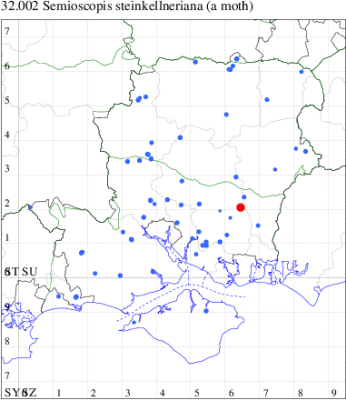
Records by year
Records by week (adult)
Records by week (larval)
Record Details
VC11: Old Winchester Hill, three, 28 Apr (F.M.G. det. RJD)
32.003 [B&F: 0668] Luquetia lobella ([Denis & Schiffermüller], 1775) - Local
Local in hedgerows and scrubland throughout most of southern England. In Hampshire recorded in small numbers, either at light or as single larvae on blackthorn, principally in the south-east of the county, rarely on the Isle of Wight. Wingspan 16-20 mm. Fairly easily recognised by the brownish grey forewing and five black wing tufts, a row of three in proximal half of forewing, and two in distal half. Larva feeds on Blackthorn, living between leaves spun together with silk, and over-wintering as a pupa.
Records prior to 2023
| Vice County | #Records | #Individuals | First Record | Last Record |
|---|---|---|---|---|
| 10 | 4 | 2 | 1949 | 2021 |
| 11 | 75 | 67 | 1974 | 2022 |
| 12 | 28 | 26 | 1979 | 2022 |
2023 records
| Vice County | #Records | #Individuals | Max Quantity |
|---|---|---|---|
| 11 | 2 | 3 | 2 |
| 12 | 3 | 3 | 1 |
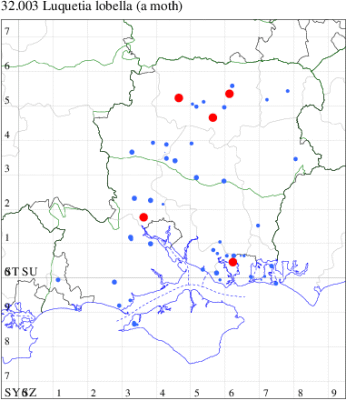
Records by year
Records by week (adult)
Records by week (larval)
Record Details
VC11: Lee, two, 09 Jun (CTha); Portchester, one, 13 Jun (DH-J);
VC12: Cole Henley*, one, 17 Jun (GCE); North Waltham, one, 10 Jun (AJon); Basingstoke, one, 12 Jun (MJW)
32.007 [B&F: 0701] Agonopterix ocellana (Fabricius, 1775) - Common
Common in a wide range of habitats, including woodland, hedgerows, parks, gardens and at freshwater margins, throughout the British Isles. In Hampshire and on the Isle of Wight widespread, but not particularly common, in damp places, where sallows and willows grow. Wingspan 19-23 mm. Larva feeds on White Willow, Purple Willow, Osier, Goat Willow, Grey Willow, Eared Willow and Creeping Willow, living between leaves spun together with silk.
Records prior to 2023
| Vice County | #Records | #Individuals | First Record | Last Record |
|---|---|---|---|---|
| 10 | 56 | 56 | 1893 | 2022 |
| 11 | 329 | 381 | 1971 | 2022 |
| 12 | 55 | 64 | 1988 | 2022 |
2023 records
| Vice County | #Records | #Individuals | Max Quantity |
|---|---|---|---|
| 11 | 11 | 12 | 2 |
| 12 | 8 | 10 | 3 |

Records by year
Records by week (adult)
Records by week (larval)
Record Details
VC11: Brockwood, one, 18 Feb; one, 18 Mar (SDut); Wildern LNR, Hedge End, one, field observation, 01 Apr (TCrw); Titchfield Haven NNR, one, 19 Aug (F.M.G.); Botley Wood, one, at dusk, 11 Feb (AMD); one, 09 Jun (F.M.G. det. RJD); Cosham, Portsmouth, present, field observation, 03 Oct (iNat); West Walk, two, 17 Feb; one, 17 Mar (F.M.G. det. RJD); Hengistbury Head, one, 03 Sep (MJef); Pennington, two, 21 Aug (RFC);
VC12: Fleet Pond, one, netted, 16 Apr; one, field observation, 13 Jul; one, netted, 03 Sep; one, field observation, 03 Aug; one, 31 Oct; one, 09 Apr; three, 20 Apr (MHals); Farnborough, one, 14 May (KBW)
32.008 [B&F: 0709] Agonopterix liturosa (Haworth, 1811) - Local
Local in England, Wales and southern Scotland; rare in Ireland. In Hampshire local and sparsely distributed across much of the county, although apparently absent from the New Forest. Not recorded from the Isle of Wight to date. Wingspan 17-20 mm. The most likely confusion species is A. conterminella, which see for differences. Larva feeds on St John's-wort, living between leaves spun together with silk.
Records prior to 2023
| Vice County | #Records | #Individuals | First Record | Last Record |
|---|---|---|---|---|
| 11 | 19 | 31 | 1973 | 2021 |
| 12 | 39 | 68 | 1977 | 2022 |
2023 records
| Vice County | #Records | #Individuals | Max Quantity |
|---|---|---|---|
| 11 | 1 | 1 | 1 |
| 12 | 2 | 2 | 1 |

Records by year
Records by week (adult)
Records by week (larval)
Record Details
VC11: East Tytherley*, one, 27 Aug (GCE);
VC12: Stockbridge Down, one, 08 Sep (MEdg); Noar Hill HIWWT NR, Selborne, one, gen. det., 10 Aug (AMD, FHay det. AMD)
32.009 [B&F: 0691] Agonopterix purpurea (Haworth, 1811) - Local
Local on downland and dry grassland throughout much of southern England and Wales, north to Lancashire. In Hampshire evidently uncommon, and absent from much of the south-west, with no recent records from the Isle of Wight. Wingspan 11-15 mm. A useful field mark is the vertical line from dorsum to upper margin of cell (MBGBI Vol 4 part 1). Larva mines leaves of Wild Carrot, Rough Chervil, Cow Parsley and Upright Hedge-parsley, subsequently living within a spun leaf.
Records prior to 2023
| Vice County | #Records | #Individuals | First Record | Last Record |
|---|---|---|---|---|
| 10 | 18 | 9 | 1856 | 2022 |
| 11 | 223 | 238 | 1990 | 2022 |
| 12 | 31 | 32 | 1987 | 2022 |
2023 records
| Vice County | #Records | #Individuals | Max Quantity |
|---|---|---|---|
| 11 | 3 | 3 | 1 |
| 12 | 1 | 1 | 1 |
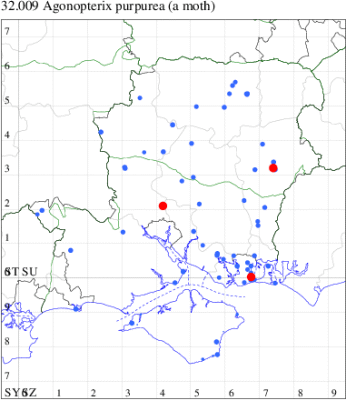
Records by year
Records by week (adult)
Records by week (larval)
Record Details
VC11: Chandler's Ford, one, 07 Aug (KArb); Portsmouth, one, 24 Apr; one, 11 May (IRT);
VC12: Noar Hill HIWWT NR, Selborne, one, field observation, 07 May (BGD)
32.011 [B&F: 0704] Agonopterix scopariella (Heinemann, 1870) - Local
Local in heathland and open woodland throughout much of Britain. In Hampshire known only from Botley Wood, Fareham and Sinah Common Hayling Island, where rare and infrequent. Recorded for the first time on the Isle of Wight at Freshwater in 2009. Wingspan 18-21 mm. The main confusion species is A. atomella, in which the ground colour of the forewing is buff, variably suffused pinkish, and the two white discal dots are lacking or indistinct and never pure white (MBGBI Vol 4 part 1), but because of its scarcity, identity should be confirmed by dissection of the genitalia. Similar also to A. heracliana and A. subpropinquella, which see for differences. Larva feeds on Broom, living between shoots spun together with silk.
Records prior to 2023
| Vice County | #Records | #Individuals | First Record | Last Record |
|---|---|---|---|---|
| 10 | 47 | 55 | 2009 | 2018 |
| 11 | 13 | 7 | 1978 | 2018 |
| 12 | 3 | 3 | 1996 | 2021 |
2023 records
| Vice County | #Records | #Individuals | Max Quantity |
|---|---|---|---|
| 12 | 2 | 2 | 1 |
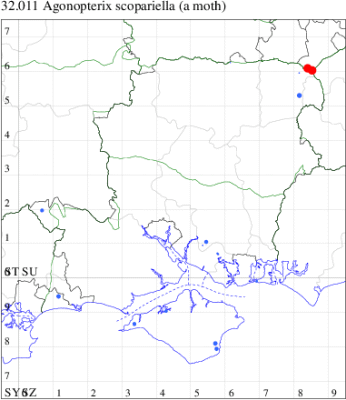
Records by year
Records by week (adult)
Records by week (larval)
Record Details
VC12: Shepherd Meadows, Blackwater*, one, field observation, gen det. , 15 Feb; one, field observation, 25 Mar (BGD)
32.012 [B&F: 0703] Agonopterix atomella ([Denis & Schiffermüller], 1775) - Nationally Scarce A
Nationally scarce (Na) on rough grassland in southern England, from Dorset eastwards, as far north as Worcestershire and Cambridgeshire; apparently absent from the Midlands, but occurring again from Cheshire northwards to Northumberland; in Wales it has been recorded from Pembrokeshire and Monmouthshire (MBGBI Vol 4 part 1), a Priority Species within the UK Biodiversity Action Plan and listed as a species of principle importance in England in Section 41 of the NERC Act, 2006.
In Hampshire the foodplant of this species is local and the moth is even rarer: it has been recorded in the past from Botley Wood (1990) and Cranmore (1981). However, it was found at Needs Ore in 1985 and a one-day survey in June 2015 found 56 larvae in six locations, and it is likely still to be present. Records were absent from the Isle of Wight since 1969, before it was found to be relatively numerous in the Newtown Common area in 2013 and there have been regular reports since - the geographical proximity of this site with Needs Ore, a stone's throw across the Solent, is probably not a coincidence. Wingspan 18-21 mm. The most likely confusion species is A. scopariella, which see for differences. Larva feeds on Dyer's Greenweed, living within a spun or rolled leaf.
Records prior to 2023
| Vice County | #Records | #Individuals | First Record | Last Record |
|---|---|---|---|---|
| 10 | 15 | 8 | 1900 | 2021 |
| 11 | 10 | 60 | 1978 | 2015 |
2023 records
| Vice County | #Records | #Individuals | Max Quantity |
|---|
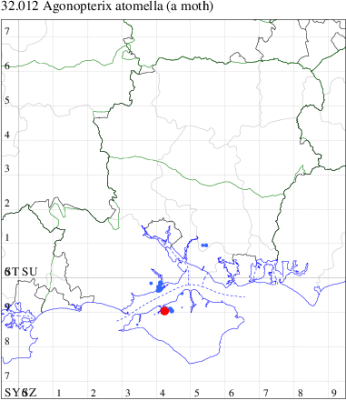
Records by year
Records by week (adult)
Records by week (larval)
Record Details
VC10: Newtown Meadows, one, field observation, 25 Jul (AMD)
32.015 [B&F: 0692] Agonopterix subpropinquella (Stainton, 1849) - Common
Common on waste ground, hedgerows and roadside verges throughout the British Isles. In south Hampshire, recorded in small numbers, mainly on Portsea and Hayling Islands; extremely uncommon in north Hampshire and on the Isle of Wight. Wingspan 16-22 mm. The main confusion species are A. scopariella, which always has two or three small white dots in the disc, A. propinquella, which has the costa more arched, with regular dark fuscous maculation, and apex more rounded, and A. carduella, which has a vertical dark mark near base half way to costa (MBGBI Vol 4 part 1). Larva feeds on Knapweed, Spear Thistle and Creeping Thistle, living within a spun or rolled leaf.
Records prior to 2023
| Vice County | #Records | #Individuals | First Record | Last Record |
|---|---|---|---|---|
| 10 | 19 | 10 | 1856 | 2020 |
| 11 | 116 | 128 | 1982 | 2020 |
| 12 | 20 | 20 | 1996 | 2022 |
2023 records
| Vice County | #Records | #Individuals | Max Quantity |
|---|---|---|---|
| 11 | 2 | 2 | 1 |
| 12 | 2 | 2 | 1 |

Records by year
Records by week (adult)
Records by week (larval)
Record Details
VC11: Winter Down Copse, Little Somborne, one, 31 Jul (GCE); Hengistbury Head, one, 17 Apr (RPH det. JOug);
VC12: Barton Stacey*, one, 08 Aug; one, 08 Aug (GCE)
32.016 [B&F: 0696] Agonopterix propinquella (Treitschke, 1835) - Local
Local in waste ground and rough grassland throughout much of England, Wales, southern Scotland and southern Ireland. In Hampshire and on the Isle of Wight there have been very few recent records of this species, and it has been recorded in recent years only from Sherborne St John and Blagden Lodge, Wildhern, in the north of the county, and Shanklin on the Isle of Wight. Wingspan 16-19 mm. The most likely confusion species is A. subpropinquella, which see for differences. Larva feeds on Creeping Thistle and Spear Thistle, living within a spun or rolled leaf.
Records prior to 2023
| Vice County | #Records | #Individuals | First Record | Last Record |
|---|---|---|---|---|
| 10 | 9 | 6 | 1856 | 2022 |
| 11 | 4 | 4 | 1980 | 2018 |
| 12 | 5 | 3 | 1996 | 2015 |
2023 records
| Vice County | #Records | #Individuals | Max Quantity |
|---|---|---|---|
| 12 | 1 | 1 | 1 |

Records by year
Records by week (adult)
Records by week (larval)
Record Details
VC12: Overton*, one, 19 Jul (ACr)
32.017 [B&F: 0697] Agonopterix arenella ([Denis & Schiffermüller], 1775) - Common
Common in rough grassland, waste ground, gardens and a wide range of other habitats throughout much of the British Isles. In Hampshire and on the Isle of Wight widespread and rather common throughout. Wingspan 16-22 mm. Larva feeds on Thistle (both Carduus and Cirsium), Knapweed, Burdock and Saw-wort, living within a spun or rolled leaf.
Records prior to 2023
| Vice County | #Records | #Individuals | First Record | Last Record |
|---|---|---|---|---|
| 10 | 191 | 234 | 1856 | 2022 |
| 11 | 712 | 778 | 1971 | 2022 |
| 12 | 218 | 230 | 1975 | 2022 |
2023 records
| Vice County | #Records | #Individuals | Max Quantity |
|---|---|---|---|
| 11 | 29 | 26 | 1 |
| 12 | 24 | 26 | 2 |
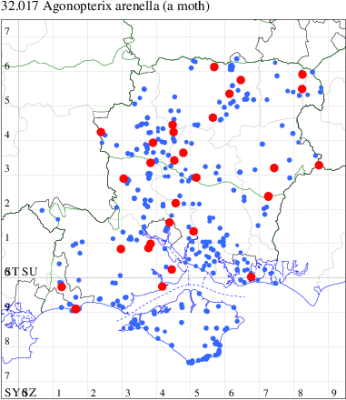
Records by year
Records by week (adult)
Records by week (larval)
Record Details
VC11: Lyndhurst, NF, one, 02 Apr (THarr); Marchwood, one, 08 May (TDCh); one, 19 Aug (CTha); East Tytherley, one, 09 Aug; Winter Down Copse, Little Somborne, one, 31 Jul (GCE); Blackfied, one, to a lighted window, 12 Feb (PGS); Swaythling, Southampton, one, 24 May (MEdg); Allbrook, one, 23 May; one, 06 Sep (SIng); Botley, one, 28 Apr; one, 23 Jul; one, 27 Jul; one, 10 Aug; one, 17 Sep (SLB); Portsmouth, one, 24 Apr (IRT); Stroud, Petersfield, one, 26 Apr; present, 27 Apr; present, 28 Apr; one, 10 Oct; present, indoors, 26 Jan; one, indoors, 18 Feb (RAll); Hurn, one, 16 Jun (MJef); Hengistbury Head, one, 16 May (BKin); one, 17 Jul; one, 18 Jul; one, 19 Jul; one, 20 Jul; one, 24 Jul (MJef); North Solent NNR, one, field observation, 05 Apr (ADT);
VC12: Cholderton, one, 29 Apr; one, 04 Sep (TJN); Chilbolton, one, 31 Aug; Littleton, one, 10 Aug; Wonston, one, 28 Aug; Longparish, one, 11 Aug; Barton Stacey, two, 08 Aug (GCE); Morn Hill, Winchester, one, 19 Aug (CRB, PDF, DAS, LHur); North Waltham, one, 17 Feb; two, 16 Apr; one, 21 Jul; one, 27 Jul; one, 11 Aug; one, 04 Sep; one, 10 Sep; one, 23 Sep (AJon); Great Haughurst Copse, Axmansford, one, 12 Aug (ACB); Basingstoke, one, 12 Jun (MJW); Sherborne St John, one, 22 Aug (AWan); Noar Hill HIWWT NR, Selborne, one, 11 Aug (AMD, FHay det. AMD); Hammer Vale, Woolmer, one, indoors, 17 Jan (ASwa); Fleet Pond, one, field observation, 26 Apr; one, field observation, 01 Jun (MHals); Yateley Common, one, 26 Aug (BGD)
32.018 [B&F: 0688] Agonopterix heracliana (Linnaeus, 1758) - Common
Common in gardens, waste ground, woodland edges and a wide range of other habitats throughout much of the British Isles. In Hampshire and on the Isle of Wight one of the most frequently reported depressariid moths, although not the most numerous. Wingspan 15-21 mm. Closely resembles A. ciliella, which see for differences. Dark chestnut forms can be confused with A. cnicella, but the latter has a smoother texture to the forewing and the pale basal area is suffused with white scales and never extended along the costa. A. scopariella has the forewing apex more squared and the white discal dots much smaller and usually not dark-circled. Small specimens can also be confused with A. capreolella which has a narrower forewing and darker hindwing, and A. curvipunctosa which has only one whitish dot in the disc of the forewing (MBGBI Vol 4 part 1). Larva feeds on Cow Parsley, Rough Chervil and Hogweed, living within a spun or rolled leaf.
Records prior to 2023
| Vice County | #Records | #Individuals | First Record | Last Record |
|---|---|---|---|---|
| 10 | 134 | 148 | 1884 | 2022 |
| 11 | 628 | 689 | 1971 | 2022 |
| 12 | 447 | 571 | 1974 | 2022 |
2023 records
| Vice County | #Records | #Individuals | Max Quantity |
|---|---|---|---|
| 11 | 19 | 19 | 3 |
| 12 | 13 | 13 | 2 |

Records by year
Records by week (adult)
Records by week (larval)
Record Details
VC11: Brockwood, one, 02 Mar (SDut); Marchwood, one, 20 Feb (TDCh); Romsey, one, 19 Mar (MJB); one, 09 Apr (NRJ); Hursley, Winchester, one, field observation, 31 Oct (PAB); Allbrook, one, 03 Feb (SIng); Botley Wood, one, at dusk, gen. & hindwing checked, 16 Feb (AMD); one, 03 Feb (F.M.G. det. RJD); Botley, one, 12 Feb (SLB); Portchester, one, 15 Feb; one, 17 Feb (DH-J); Portsmouth, three, 16 Mar (IRT); West Walk, one, 17 Mar (F.M.G. det. RJD); Stroud, Petersfield, present, 27 Jan; one, 02 Feb; present, 11 Feb; one, 18 Feb; present, 22 Feb (RAll); Hordle, two, field observation, 28 Sep (SKee);
VC12: Grayshott, one, 18 Apr (THard); Magdalen Hill Down NR, one, at dusk, 23 Jul (AMD); Morn Hill, Winchester, one, 08 Jul (CRB, PDF, DAS, LHur); Ecchinswell, one, to a lighted window, 05 Jan; one, to a lighted window, 03 Feb; one, to a lighted window, 12 Jul; one, indoors, 20 Sep; one, indoors, 30 Oct (MJN); Tadley, present, field observation, 15 Mar (iNat); Alton, two, 19 Mar; one, to artificial light, 25 Mar (DBO); Blackwater, one, field observation, 19 Mar; Shepherd Meadows, Blackwater, one, field observation, 15 Feb (BGD)
32.024 [B&F: 0702] Agonopterix assimilella (Treitschke, 1832) - Local
Local on heathland and in open woodland throughout much of Britain; rare in Ireland. In Hampshire widespread wherever Broom is found, but there have been no recent records from the Isle of Wight. Wingspan 15-21 mm. Most likely to be confused with A. nanatella, which see for differences; A. angelicella, which has a similarly shaped fuscous discal blotch, but it incorporates a black dot, and the forewing is usually orange-coloured; and A. kuznetzovi, in which the hindwing is dark grey, the cloudy fuscous blotch in the forewing is at one-half and never extended toward tornus, and there is a black discal dot at three-fifths which is absent in A. assimilella (MBGBI Vol 4 part 1). Larva feeds within stems of Broom, subsequently living between spun stems.
Records prior to 2023
| Vice County | #Records | #Individuals | First Record | Last Record |
|---|---|---|---|---|
| 10 | 2 | 1 | 1900 | 2010 |
| 11 | 40 | 22 | 1972 | 2022 |
| 12 | 24 | 16 | 1988 | 2022 |
2023 records
| Vice County | #Records | #Individuals | Max Quantity |
|---|---|---|---|
| 11 | 1 | 2 | 2 |
| 12 | 2 | 2 | 1 |
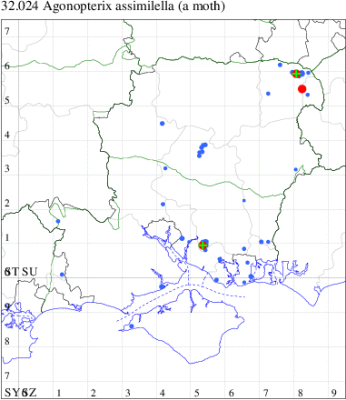
Records by year
Records by week (adult)
Records by week (larval)
Record Details
VC11: Botley Wood, larva, two, field observation, 07 Jan (AMD);
VC12: Yateley Common, larva, one, field observation, 09 Apr (BGD); Fleet Pond, one, 17 Jun (MHals)
32.026 [B&F: 0698] Agonopterix kaekeritziana (Linnaeus, 1767) - Local
Local on downland, open grassland, roadside verges and flower meadows throughout much of the British Isles, except for parts of the Highlands of Scotland and Shetland. In Hampshire and on the Isle of Wight widespread and frequent amongst knapweed. Wingspan 19-23 mm. Most likely to be confused with A. bipunctosa and A. pallorella, both of which lack any trace of rusty orange coloration and have a more definitive subdorsal dot near the base of the forewing (MBGBI Vol 4 part 1). Larva feeds on Common Knapweed and Greater Knapweed, living within a spun or rolled leaf.
Records prior to 2023
| Vice County | #Records | #Individuals | First Record | Last Record |
|---|---|---|---|---|
| 10 | 9 | 2 | 1850 | 1981 |
| 11 | 40 | 32 | 1973 | 2021 |
| 12 | 21 | 20 | 1980 | 2022 |
2023 records
| Vice County | #Records | #Individuals | Max Quantity |
|---|---|---|---|
| 11 | 1 | 1 | 1 |
| 12 | 5 | 5 | 1 |
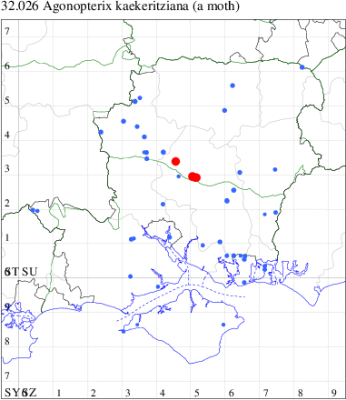
Records by year
Records by week (adult)
Records by week (larval)
Record Details
VC12: Littleton, one, 10 Aug (GCE); Magdalen Hill Down NR*, one, at dusk, 23 Jul (AMD); Magdalen Hill Down NNR*, one, 21 Jul (SIng, PPea); Morn Hill, Winchester*, one, 08 Jul (CRB, PDF, DAS, LHur); one, 11 Aug (CRB, DAS)
32.030 [B&F: 0706] Agonopterix nervosa (Haworth, 1811) - Common
Common on heathland and grassland, and in open woodland, throughout much of the British Isles. In Hampshire and on the Isle of Wight common wherever gorse or broom grows. Wingspan 16-22 mm. Larva feeds within young shoots of Broom, Gorse, Dyer's Greenweed and Petty Whin, beneath a silken web.
Records prior to 2023
| Vice County | #Records | #Individuals | First Record | Last Record |
|---|---|---|---|---|
| 10 | 33 | 31 | 1856 | 2021 |
| 11 | 173 | 223 | 1971 | 2022 |
| 12 | 24 | 26 | 1977 | 2022 |
2023 records
| Vice County | #Records | #Individuals | Max Quantity |
|---|---|---|---|
| 11 | 2 | 2 | 1 |
| 12 | 2 | 2 | 1 |

Records by year
Records by week (adult)
Records by week (larval)
Record Details
VC11: Botley, one, 12 Sep (SLB); Hengistbury Head, one, 05 Jul (MJef);
VC12: Whitehill, one, 23 Aug (ASto); Yateley Common, one, field observation, 26 Aug (BGD)
32.031 [B&F: 0695] Agonopterix alstromeriana (Clerck, 1759) - Common
Common on roadside verges, waste ground, marshes and river-banks throughout the British Isles, but not in the far north. In Hampshire and on the Isle of Wight local and seldom seen in numbers, despite being one of the easiest species of this group to identify. Wingspan 17-20 mm. Fairly unmistakable combination of large black costal blotch and adjacent rusty red elongate mark, and prominent apical dots. Larva feeds on flowers and leaves of Hemlock, living within a spun or rolled leaf.
Records prior to 2023
| Vice County | #Records | #Individuals | First Record | Last Record |
|---|---|---|---|---|
| 10 | 20 | 12 | 1856 | 2020 |
| 11 | 531 | 962 | 1977 | 2022 |
| 12 | 103 | 98 | 1990 | 2022 |
2023 records
| Vice County | #Records | #Individuals | Max Quantity |
|---|---|---|---|
| 11 | 17 | 16 | 1 |
| 12 | 5 | 5 | 1 |
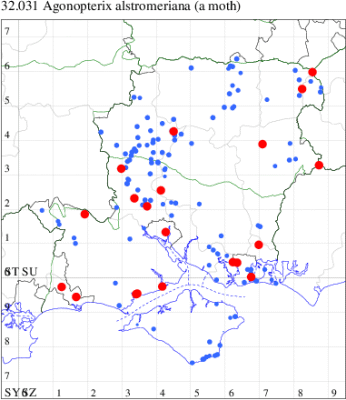
Records by year
Records by week (adult)
Records by week (larval)
Record Details
VC11: Hale Purlieu, NF, one, 10 Aug (JPuz); Broughton*, one, 09 Aug (GCE); Stanbridge Earls, one, 10 Sep (JRM); Romsey, one, 27 Jul (MJB); Southampton, one, field observation, 21 Feb (JOug); Hursley, Winchester, one, field observation, 25 Oct (PAB); Portchester, one, 07 Jul (DH-J); Horsea Island, one, 29 Sep (F.M.G.); Portsmouth, one, 16 Mar (IRT); Waterlooville, one, 20 Oct (DWhe); Hurn, one, field observation, hibernating in shed. , 30 Jan; one, 13 Jul; one, to a lighted window, 06 Nov (MJef); Burton, nr Christchurch, one, 22 Nov (JStw); Lisle Court, Lymington*, one, 09 Sep (AMus, JPMar det. JPM); present, 09 Sep (AMus); North Solent NNR*, one, field observation, 09 Dec (ADT);
VC12: Barton Stacey, one, 11 Sep (GCE); Alton, one, to artificial light, 16 Sep (DBO); Hammer Vale, Woolmer, one, indoors, 06 Sep (ASwa); Fleet Pond, one, 10 Aug (MHals); Blackwater, one, 27 Jun (BGD)
32.035 [B&F: 0714] Agonopterix yeatiana (Fabricius, 1781) - Local
Local on grassland, downland and in dry open areas in parts of the British Isles, predominantly coastal, especially in Scotland and Ireland. In Hampshire fairly widespread and locally common, but not recorded recently on the Isle of Wight. Wingspan 18-22 mm. The most likely confusion species is A. putridella, which see for differences. Larva feeds on Wild Carrot, Pepper-saxifrage, Rough Chervil, Hemlock Water-dropwort and Milk-parsley, living between leaves spun together with silk.
Records prior to 2023
| Vice County | #Records | #Individuals | First Record | Last Record |
|---|---|---|---|---|
| 10 | 36 | 28 | 1856 | 2020 |
| 11 | 439 | 551 | 1976 | 2022 |
| 12 | 54 | 82 | 1990 | 2022 |
2023 records
| Vice County | #Records | #Individuals | Max Quantity |
|---|---|---|---|
| 11 | 10 | 9 | 1 |
| 12 | 2 | 3 | 2 |

Records by year
Records by week (adult)
Records by week (larval)
Record Details
VC11: Marchwood*, one, 27 Apr (TDCh); Winter Down Copse, Little Somborne, one, 31 Jul (GCE); Fareham, one, 16 May; one, 06 Jun (MLO); Portchester, one, 10 May (DH-J); Hurn, one, 08 May (MJef); Hengistbury Head, one, 26 Mar (RPH); Lisle Court, Lymington, one, 08 Sep (AMus, JPMar det. JPM); present, field observation, 09 Sep (MPrnc); one, 08 Sep (AMus);
VC12: Cholderton, two, 29 Jul; one, 04 Sep (TJN)
32.036 [B&F: 0672] Parsnip Moth Depressaria radiella (Goeze, 1783) - Common
Common on waste ground and dry grassland throughout much of the British Isles, more numerous on the coast. In Hampshire and on the Isle of Wight common and widespread. Wingspan 24-29 mm. separated from similar species by numerous longitudinal black streaks emanating from central area of disc, closely following venation, most terminating at fascia at three-quarters, a few passing through but always finishing before termen (MBGBI Vol 4 part 1). The imago overwinters, and may be found in man-made habitat such as thatch, stables and outhouses. Larva feeds on flowers and seeds of Wild Parsnip and Hogweed, living gregariously within spun or rolled leaves.
Records prior to 2023
| Vice County | #Records | #Individuals | First Record | Last Record |
|---|---|---|---|---|
| 10 | 166 | 280 | 1856 | 2022 |
| 11 | 268 | 356 | 1973 | 2022 |
| 12 | 140 | 210 | 1976 | 2022 |
2023 records
| Vice County | #Records | #Individuals | Max Quantity |
|---|---|---|---|
| 11 | 16 | 22 | 5 |
| 12 | 13 | 14 | 2 |
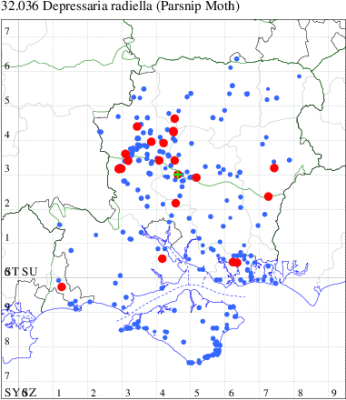
Records by year
Records by week (adult)
Records by week (larval)
Record Details
VC11: East Tytherley, one, 27 Aug; one, 27 Aug; Broughton, one, 27 Aug; two, 09 Aug; one, 22 Aug (GCE); Dibden Purlieu, NF, one, 07 Sep (RAC); Allbrook, one, 07 May (SIng); Crawley, two, 20 Aug (GCE); Teg Down, Winchester, larva, five, field observation, larval spinnings in hogweed seeds and entrance holes in stem. , 29 Jul (WLan); Portchester, one, 07 May (DH-J); Horsea Island, one, 21 Jul; one, 21 Jul (F.M.G.); Stroud, Petersfield*, one, 25 Sep; one, 22 Nov (RAll); Hurn, one, 20 Feb; one, 20 Apr (MJef);
VC12: Nether Wallop, one, 22 Aug; Wherwell, one, 07 Sep (GCE); Anna Valley, Andover, one, 22 Aug (TJN); Newton Stacey, one, 16 Aug; Littleton, one, 10 Aug; Barton Stacey, one, 11 Sep; one, 08 Aug; Hurstbourne Priors, one, 11 Aug (GCE); Morn Hill, Winchester, one, 10 Jun (CRB, DAS, PDF et al); one, 10 Jun; two, 19 Aug (CRB, PDF, DAS, LHur); one, 02 Sep (CRB, PDF, DAS); Noar Hill HIWWT NR, Selborne, one, 01 Sep (AMD, FHay det. AMD)
32.038 [B&F: 0674] Depressaria badiella (Hübner, 1796) - Local
Local in sandhills and quarries throughout the British Isles. In Hampshire confined to a few sites, most numerously at Micheldever Spoil Heaps, but also at Itchen Abbas, Portsdown and Oxenbourne; very rare on the Isle of Wight, where recorded only once, on Tennyson Down. Wingspan 18-22 mm. The almost unicolorous and unmarked forewing with a dark basal lobe helps to distinguish the most common forms of this species from others in the genus. Larva feeds on leaves of Perennial Sow-thistle, Dandelion and Cat's-ear, subsequently feeding in the roots.
Records prior to 2023
| Vice County | #Records | #Individuals | First Record | Last Record |
|---|---|---|---|---|
| 10 | 10 | 4 | 1856 | 2013 |
| 11 | 14 | 43 | 1973 | 2022 |
| 12 | 14 | 25 | 1950 | 2021 |
2023 records
| Vice County | #Records | #Individuals | Max Quantity |
|---|---|---|---|
| 11 | 2 | 2 | 1 |
| 12 | 1 | 1 | 1 |
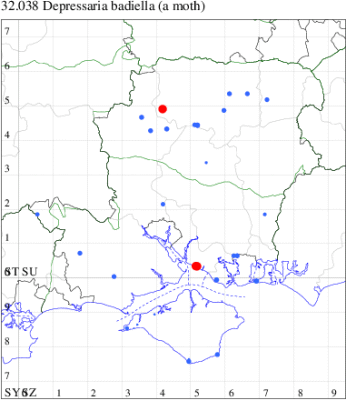
Records by year
Records by week (adult)
Records by week (larval)
Record Details
VC11: Brownwich cliffs*, one, male gen det. , 07 Jul; Brownwich Cliffs, Titchfield*, one, 07 Jul (F.M.G.);
VC12: Lower Wyke Farm, St Mary Bourne, one, 01 Sep (GCE)
32.039 [B&F: 0670] Depressaria daucella ([Denis & Schiffermüller], 1775) - Common
Common in ditches, marshes, river-banks, water meadows and damp moorland throughout much of Britain, more numerous in the west, and apparently absent from northern Scotland, Orkney, and Shetland; also recorded from several Irish sites. In Hampshire common and widespread in marshes and ditches where the foodplant, mainly Hemlock Water-dropwort, occurs; very local on the coast of the Isle of Wight. Wingspan 22-25 mm. Resembles D. ultimella, which has a smaller wingspan and disc of the forewing conspicuously cream; in D. daucella the disc is buff and inconspicuous. Like many Depressaria, it overwinters, and is often recorded hibernating in thatch. Larva mines flowering stems of various species of Water-dropwort, subsequently feeding on the flowers and seed heads.
Records prior to 2023
| Vice County | #Records | #Individuals | First Record | Last Record |
|---|---|---|---|---|
| 10 | 105 | 373 | 1893 | 2022 |
| 11 | 405 | 1401 | 1974 | 2022 |
| 12 | 52 | 98 | 1981 | 2022 |
2023 records
| Vice County | #Records | #Individuals | Max Quantity |
|---|---|---|---|
| 11 | 8 | 8 | 1 |
| 12 | 2 | 2 | 1 |

Records by year
Records by week (adult)
Records by week (larval)
Record Details
VC11: Marchwood, one, 09 Apr; one, indoors, 28 Oct (CTha); Blackfield, one, 23 Sep (SJJ); Blackfied, one, to a lighted window, 16 Apr (PGS); Botley, one, 17 Mar; one, 28 Mar (SLB); Portsmouth, one, 19 Aug (IRT); Old Winchester Hill*, one, female gen.det. , 28 Apr (F.M.G. det. RJD);
VC12: Hammer Vale, Woolmer*, one, 06 Sep (ASwa); Hawley Meadows, larva, one, field observation, 11 Jun (BGD)
32.040 [B&F: 0671] Depressaria ultimella Stainton, 1849 - Local
Local in ditches, marshes and water meadows, and on river-banks in southern England from Kent to Cornwall, through central England as far north as Lancashire and north-east Yorkshire; also in Wales and southern Ireland. In Hampshire there are a few scattered records in both the north and south, and first recorded on the Isle of Wight at Freshwater in 2010. Wingspan 16-21 mm. Resembles D. daucella, which see for differences. Larva feeds on stems and leaves of Fool's Water-cress, Greater Water-parsnip, Hemlock Water-dropwort and Fine-leaved Water-dropwort, overwintering as an adult.
Records prior to 2023
| Vice County | #Records | #Individuals | First Record | Last Record |
|---|---|---|---|---|
| 10 | 2 | 3 | 2010 | 2020 |
| 11 | 14 | 16 | 1982 | 2022 |
| 12 | 13 | 15 | 1996 | 2021 |
2023 records
| Vice County | #Records | #Individuals | Max Quantity |
|---|---|---|---|
| 11 | 2 | 2 | 1 |
| 12 | 1 | 1 | 1 |
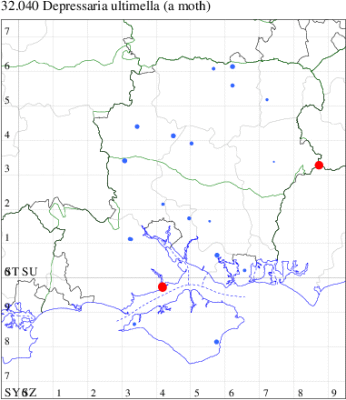
Records by year
Records by week (adult)
Records by week (larval)
Record Details
VC11: North Solent NNR*, one, field observation, gen det, specimen retained. , 09 Dec; Needs Ore NNR*, one, seen by day, male, at rest in the toilet block. Genitalia 10,550., 09 Dec (ADT det. RJD);
VC12: Hammer Vale, Woolmer*, one, indoors, 16 Dec (ASwa)
32.044 [B&F: 0677] Depressaria douglasella Stainton, 1849 - Nationally Scarce B
Nationally scarce (Nb) in grassland and waste ground throughout much of England. In Hampshire and on the Isle of Wight recorded from a handful of sites, and quite rare in North Hampshire. Wingspan 17-21 mm. The main confusion species are D. pulcherrimella, in which the angle made by the pale fascia on the forewing forms a right-angle (obtusely angled in A, douglasella), and D. sordidatella, which differs in the slightly glossy, less heavily marked forewing and the darker head, thorax and tegulae (MBGBI Vol 4 part 1). Larva feeds on Wild Carrot, Wild Parsnip and Upright Hedge-parsley, living between leaves spun together with silk.
Records prior to 2023
| Vice County | #Records | #Individuals | First Record | Last Record |
|---|---|---|---|---|
| 10 | 6 | 3 | 1893 | 2022 |
| 11 | 14 | 12 | 1975 | 2021 |
| 12 | 6 | 5 | 1979 | 2022 |
2023 records
| Vice County | #Records | #Individuals | Max Quantity |
|---|---|---|---|
| 12 | 4 | 5 | 2 |
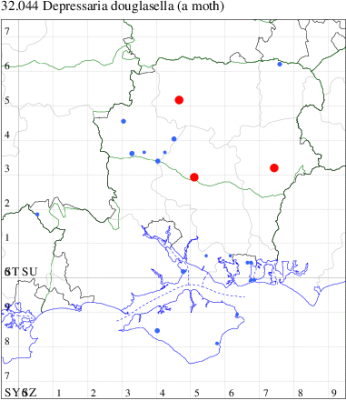
Records by year
Records by week (adult)
Records by week (larval)
Record Details
VC12: Cole Henley*, one, 27 Jul (GCE); Magdalen Hill Down NR*, one, gen. det., 23 Jul (AMD); Noar Hill HIWWT NR, Selborne*, two, 1m gen. det., 11 Aug; one, gen. det., 01 Sep (AMD, FHay det. AMD)
32.047 [B&F: 0682] Depressaria chaerophylli Zeller, 1839 - Local
Local in mature hedgerows, woodland edges and old sunken lanes in southern England, the Midlands and East Anglia, with records north to Durham. The presence of this species in Hampshire was confirmed in the late 1970s, when a few specimens were taken at light and larvae were located on Rough Chervil in the Winchester area. Since then a few individuals have turned up in scattered localities, including two in the Basingstoke area. Not recorded from the Isle of Wight since 1856. Wingspan 19-22 mm. Similar to D. depressana, which see for differences, and D. pimpinellae, from which D. chaerophylli can be separated by the restriction of the reddish brown ground colour to the inner one-quarter of the forewing, and the conspicuous black spotting along the termen (MBGBI Vol 4 part 1). Larva feeds on Rough Chervil, living between flowers spun together with silk.
Records prior to 2023
| Vice County | #Records | #Individuals | First Record | Last Record |
|---|---|---|---|---|
| 10 | 1 | 0 | 1856 | 1856 |
| 11 | 8 | 4 | 1700 | 2021 |
| 12 | 25 | 27 | 2000 | 2022 |
2023 records
| Vice County | #Records | #Individuals | Max Quantity |
|---|---|---|---|
| 12 | 1 | 1 | 1 |
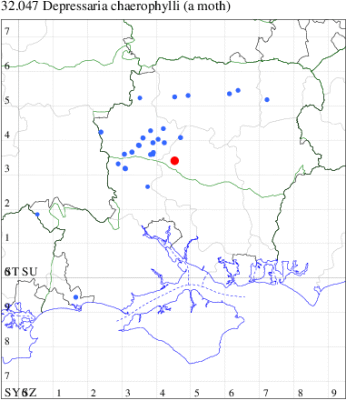
Records by year
Records by week (adult)
Records by week (larval)
Record Details
VC12: Littleton, one, 10 Aug (GCE)
32.050 [B&F: 0646] Telechrysis tripuncta (Haworth, 1828) - Nationally Scarce B
Nationally scarce (Nb) in woodland and hedgerows in parts of England, except the north-east, and in north Wales. A scarcely seen insect in Hampshire with a very scattered distribution, mainly away from the chalk; there are two old records from the Isle of Wight. Wingspan 11-14 mm. The three pale, evenly-spaced spots on each forewing make this a distinctive member of the Oecophoridae. Larva feeds on dead wood, perhaps most frequently of Hazel.
Records prior to 2023
| Vice County | #Records | #Individuals | First Record | Last Record |
|---|---|---|---|---|
| 10 | 30 | 35 | 1900 | 2022 |
| 11 | 23 | 23 | 1973 | 2012 |
| 12 | 9 | 16 | 1992 | 2022 |
2023 records
| Vice County | #Records | #Individuals | Max Quantity |
|---|---|---|---|
| 11 | 1 | 1 | 1 |
| 12 | 2 | 2 | 1 |
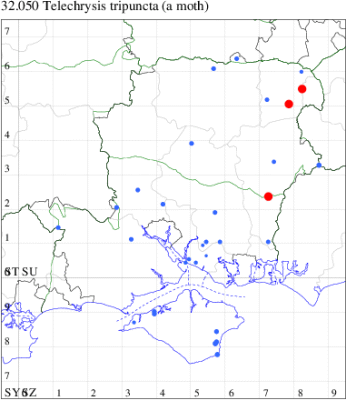
Records by year
Records by week (adult)
Records by week (larval)
Record Details
VC11: Stroud, Petersfield*, one, 05 Jun (RAll);
VC12: Rye Common, one, netted, 06 Jun (AMD); Fleet Pond, one, 10 Jun (MHals)
